
I feel bad.
I meant to get this post out before Christmas. I know some people wanted the recipe last week. But there was last minute shopping to do and the kids started flying into town and before I knew it, I was knee-deep in cookie dough and gift wrapping supplies and I just ran out of time. Oh, we got married last night too, at our annual Day-After-Christmas Party. So you see, I've been kinda' busy.
~~~
Luckily, Candied Orange Peels are something you can make any time of the year, and they taste just as festive in June as they do in January. I like to use Cara Cara* oranges for this recipe, but you can easily use other types of oranges as well as grapefruits, lemons & limes. Organic is always the best way to go, but no matter what type of citrus you decide to use, be sure to give them a good scrubbing, to rid the rind of the bad stuff, like dirt and wax, and oh...don't forget to take those sticky labels off.
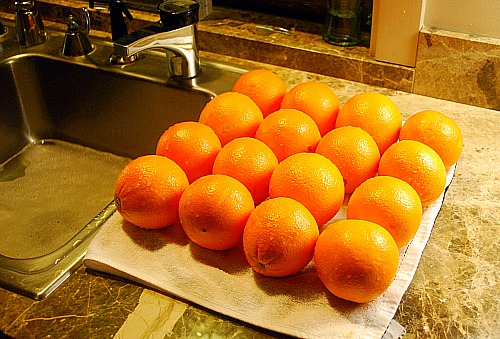
Yes, you are going to boil the peels, so of course the dirt will be washed off, but you will want to save the flesh of the citrus to eat later, and you don't want any cross-contamination, do you? Take the time to scrub them well.
Helpful hint: I wear protective gloves when making this recipe. I find that the process of peeling the oranges can be tough on my fingertips. Something about the citric acid and/or the oils in the zest is very abrasive. Maybe it's just me -- and maybe it's because I sometimes do a dozen oranges at a time -- but it's better to be safe than sorry. Wearing snug-fitting gloves makes handling the knife easier too, not loose ones like I'm wearing in these photos! Geez.
~~~
After washing, score the fruit, from end to end, dividing the fruit into quarters.

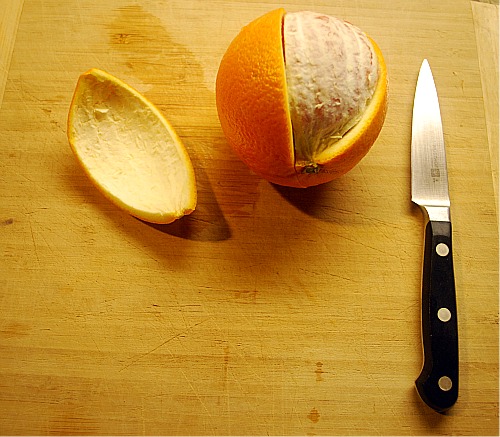 Some people cut both ends of the orange off first, but I usually don't do it that way. It results in squared-off edges in the final product, which looks very nice, but I hate to waste even a tiny bit of fruit.
Some people cut both ends of the orange off first, but I usually don't do it that way. It results in squared-off edges in the final product, which looks very nice, but I hate to waste even a tiny bit of fruit.
Slice quartered sections into strips....
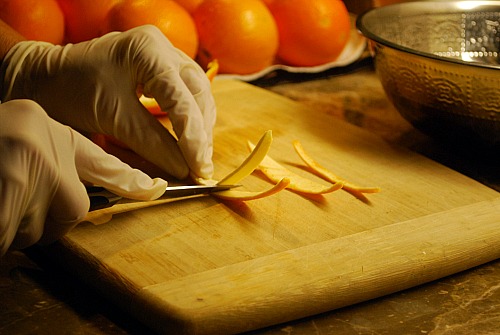
...then run a sharp paring knife the length of the peel, being careful to just cut away the layer of white pith.
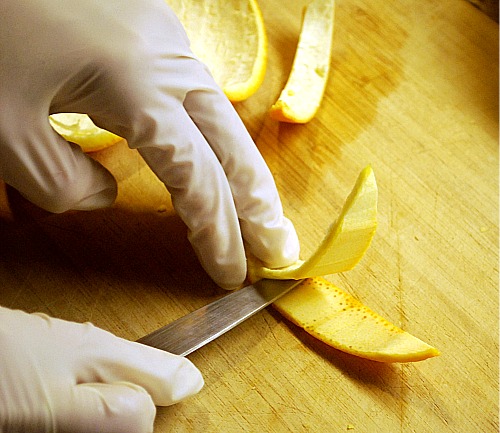
This white pith can be bitter, or it might become unappealing mushy when the peels are cooked.
Set fruit aside for another use.
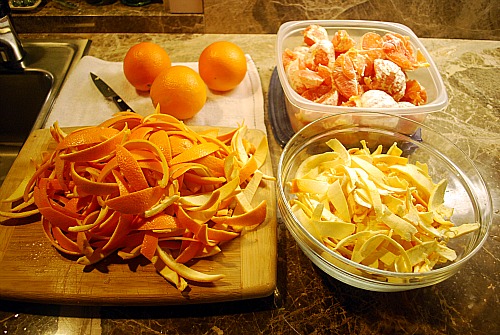 Seven pounds' worth of peels
Seven pounds' worth of peels
Put prepared peels into a large pot, add enough cold water to cover, and bring to a boil, then drain. Repeat the cold water / boil / drain process two more times.
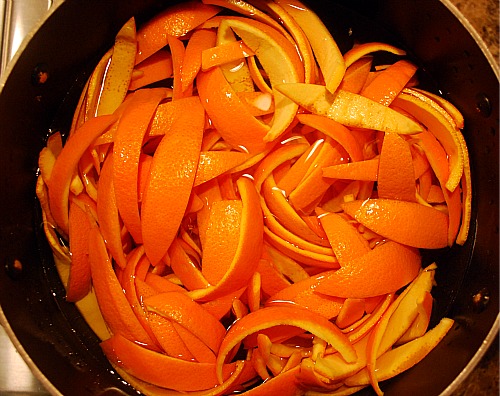
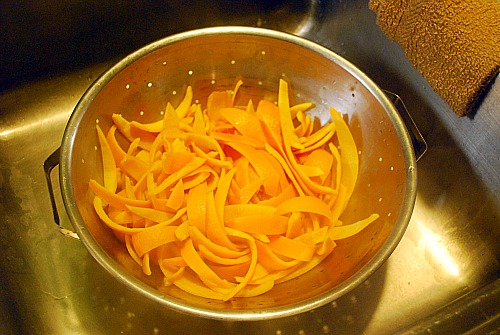 Boil > drain > boil > drain > boil > drain.
Boil > drain > boil > drain > boil > drain.
Make a syrup -- by heating to a boil --1 cup of sugar and 2 cups of water for every 2 oranges that you use. Stir syrup until sugar dissolves, then add the peels and boil lightly for 30-45 minutes, or until orange peels are translucent.
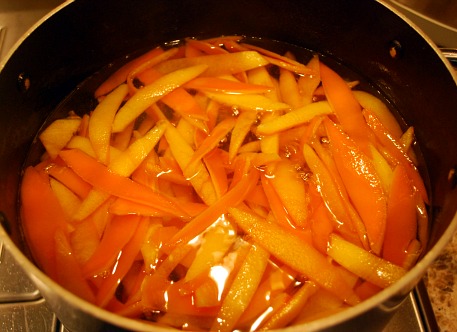
Remove from heat and drain, using a colander OVER A BOWL (so that you can save the syrup for other uses, like sweetening tea or mixing with club soda & ice to make a slightly citrus-y sweet bubbly beverage.)
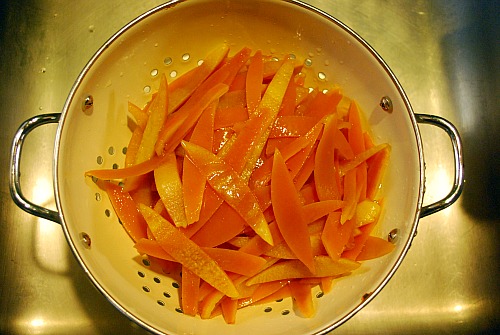
Place wire racks over wax paper (so that you can save any sugar that falls off of the peels during the next process., and save it for other uses.)
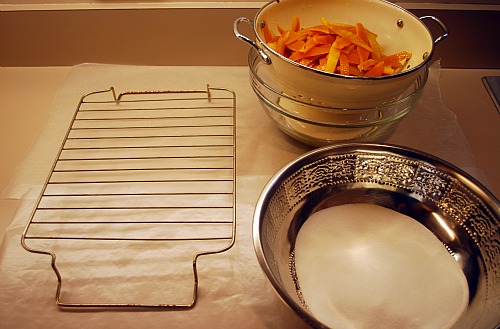
Dredge peels in sugar, then transfer to the racks to dry.
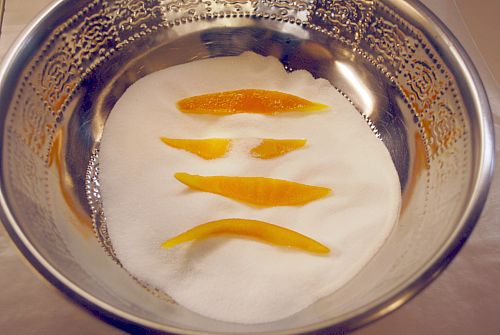

Some people like to dip their peels a second time, after the peels have absorbed some of the sugar.
Peels might take up to 24 hours to dry.
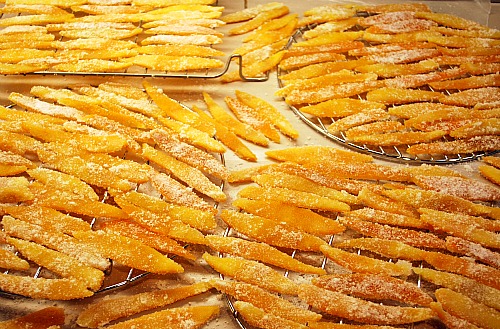
They can be left "plain" or dipped in melted chocolate. For dipping, use white, dark, bittersweet, semisweet or milk chocolate..whatever you prefer...it all tastes good!
Stored in an airtight container, they will keep for several weeks.
You can also put a few in a small cellophane bag...
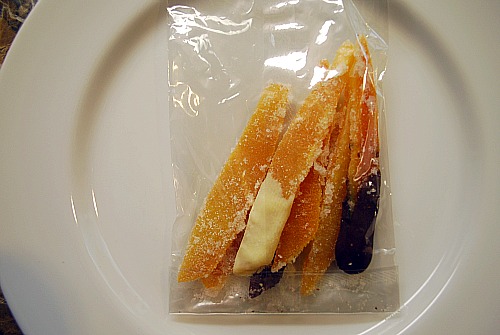
...add a fun wired ribbon and an inexpensive return address-style label...
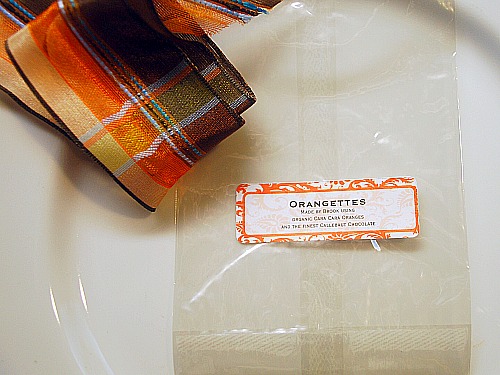
...and they make a pretty cute little hostess gift!
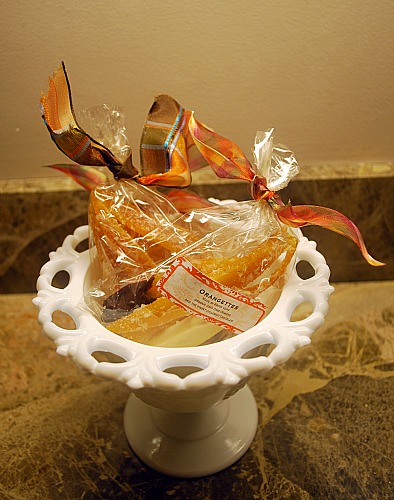
*Cara Cara Oranges are a special cultivar of a navel orange which are distinguished by their rosy flesh. Depending on the orange, the color may range from a pinkish to a deep red, much like that of the grapefruit. Unlike grapefruits, however, Cara Cara Oranges are very low in acid, with a naturally sweet flavor. Some people feel that they are superior to other navel orange varieties in flavor, and they are often in high demand in produce markets when they are in season, which is December and January in the Northern Hemisphere.
Please click here to return to my original blog, which is full of other tasty ideas>>>
(2009 Orangettes)